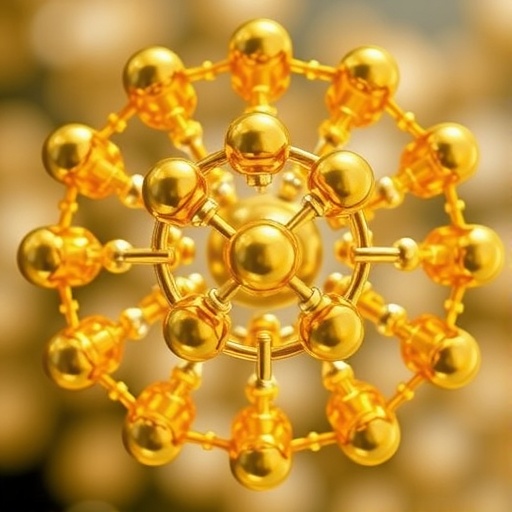In the relentless pursuit of enhancing catalytic materials, researchers have delved deep into the microscopic world of platinum-rhodium nanoparticles, unveiling how their atomic architecture and chemical behavior hold the key to revolutionizing catalytic performance. These nanoparticles, diminutive beyond comprehension at less than one ten-thousandth of a millimeter in diameter, possess extraordinarily high surface areas relative to their mass, rendering them exceptional candidates for catalysis in environmental protection, industrial synthesis, and sustainable fuel production. Recent cutting-edge investigations have brought new clarity to how the delicate interplay between platinum cores and rhodium shells governs these particles’ reactivity and longevity under operational conditions.
Platinum has long been heralded as a titan in the realm of catalysis, employed notably in heterogeneous gas-phase catalysis to mitigate harmful emissions such as carbon monoxide in automotive exhaust. However, the remarkable properties offered by rhodium, another precious metal, have prompted scientists to explore bimetallic combinations for enhanced catalytic efficacy. An especially promising configuration, the platinum core with an ultra-thin rhodium shell, has become the focal point of study, aiming to optimize the elemental distribution to increase catalyst durability and functionality.
Delving into the nanoscale, understanding how the surface chemistry of these core-shell nanoparticles evolves during catalysis has posed a formidable challenge. A team spearheaded by Dr. Thomas F. Keller at DESY NanoLab employed a combination of advanced microscopy and spectroscopic techniques to uncover the surface transformations that occur. Notably, they capitalized on the unique capabilities of the BESSY II synchrotron radiation source and the SMART instrument at the Fritz Haber Institute to conduct spatially resolved chemical analysis with unparalleled precision.
The investigative journey began with meticulous characterization in the electron microscopes housed within the DESY NanoLab, utilizing scanning electron microscopy (SEM) and atomic force microscopy (AFM) to locate and map individual Pt-Rh nanoparticles with nanoscale accuracy. This foundational step was critical for ensuring that subsequent spectroscopic measurements could be precisely correlated with the observed structural features, setting the stage for a comprehensive study of chemical dynamics under catalytic conditions.
Employing X-ray photoemission electron microscopy (XPEEM) at the SMART instrument, researchers could selectively probe chemical species on the nanoparticles’ surfaces with a spatial resolution of just 5 to 10 nanometers—a remarkable feat that allowed for element-specific imaging. This technique illuminated how rhodium atoms behave when subjected to changing environmental conditions representative of catalytic operation, such as exposure to reducing hydrogen atmospheres and oxidizing oxygen environments.
One of the ground-breaking revelations was the observation that rhodium is not simply a static shell around the platinum core; rather, it actively diffuses into the platinum lattice during catalysis, a dynamic process influenced heavily by operating temperature and gas atmosphere. Under reducing conditions dominated by hydrogen, this Rh-to-Pt diffusion accelerates, suggesting a deeper atomic intermixing that can modify the catalyst’s surface properties profoundly. Conversely, oxidizing oxygen environments suppress but do not reverse this migration, indicating a net transfer of rhodium into the core structure.
Temperature intensifies these effects, with higher heat amplifying the alloying process between the platinum and rhodium. Such thermal sensitivity emphasizes the necessity for precise thermal management in catalytic systems to balance the beneficial and potentially adverse impacts of elemental mixing on catalyst activity and stability. This diffusion phenomenon hints at an intrinsic self-adjusting mechanism within these nanoparticles, potentially prolonging their operational lifespan and effectiveness.
Beyond elemental distribution, the study unveiled the critical influence of the nanoparticles’ crystallographic facets on catalytic behavior. The Pt-Rh nanoparticles have polyhedral shapes with multiple facets, each presenting distinct atomic arrangements and step edges—regions characterized by under-coordinated atoms. Catalytic reaction rates were found to be facet-dependent, with pronounced activity on surfaces abundant in atomic steps. Particularly, rhodium oxidation was most prominent on these stepped facets, underscoring the importance of precise control over nanoparticle morphology to fine-tune catalytic performance.
These insights into facet-specific oxidation dynamics bear significant implication for the design of nanocatalysts, especially considering that such oxidation can irreversibly alter the nanoparticles during usage, leading to performance degradation. Understanding the interplay between facet geometry and chemical reactivity provides a roadmap to engineer catalysts with tailored surface structures that maximize efficiency while mitigating deactivation pathways.
The experimental approach combining microscopy with spectroscopy at BESSY II represents a milestone in catalyst research, as it transcends traditional bulk analyses and offers a nanoscale window into live chemical processes. This facet-resolved spectro-microscopy methodology paves the way for rational catalyst design wherein atomic-scale insights directly inform the synthesis of more robust and effective catalytic nanomaterials.
Looking forward, the knowledge gained from this study could guide the development of next-generation catalysts capable of driving sustainable chemical transformations, including the efficient conversion of carbon dioxide and hydrogen into fuels and valuable chemicals. Fine-tuning the Pt-Rh core-shell architecture could yield catalysts that balance activity, selectivity, and longevity—critical parameters for industrial and environmental applications.
Moreover, the demonstrated ability to monitor real-time chemical changes at the nanoscale establishes a versatile framework applicable beyond platinum-rhodium systems, extending to a broad spectrum of bimetallic or multicomponent catalysts. This cross-cutting potential ensures that such advances will have ripple effects throughout materials science and catalysis, accelerating innovations in energy conversion and pollution control technologies.
As the race toward cleaner and more sustainable technologies intensifies, the union of precise nanoscale characterization and intelligent catalyst design embodied in this research points the way forward. The fusion of experimental spectroscopy and microscopy tools, coupled with strategic elemental engineering, can unlock unprecedented catalytic behaviors, forging pathways toward environmental remediation and green chemistry that are both effective and economically viable.
Subject of Research: Not applicable
Article Title: Spectro-Microscopy of Individual Pt–Rh Core–Shell Nanoparticles during Competing Oxidation and Alloying
News Publication Date: 30-Jul-2025
Web References: 10.1021/acsnano.5c07668
Image Credits: Arno Jeromin, DESY NanoLab
Keywords
Physical sciences, Chemistry, Catalytic efficiency
Tags: automotive exhaust emission reductionbimetallic catalyst combinationscatalysis in metallic nanocatalystscatalytic performance enhancementcore-shell nanoparticle architectureenvironmental protection catalysisheterogeneous gas-phase catalysisindustrial synthesis catalystsnanoparticle reactivity and longevityplatinum-rhodium nanoparticlessurface chemistry in catalysissustainable fuel production





